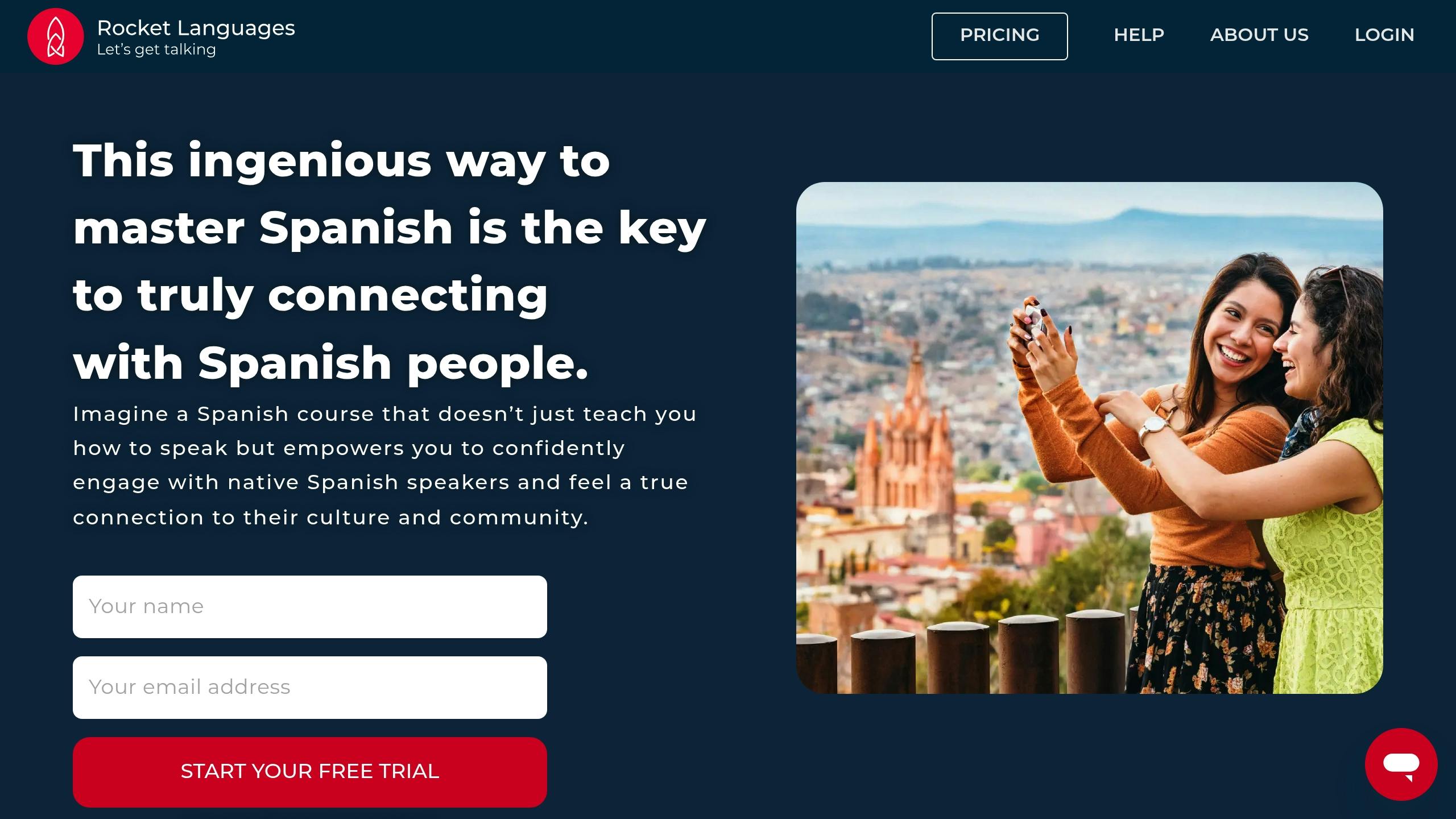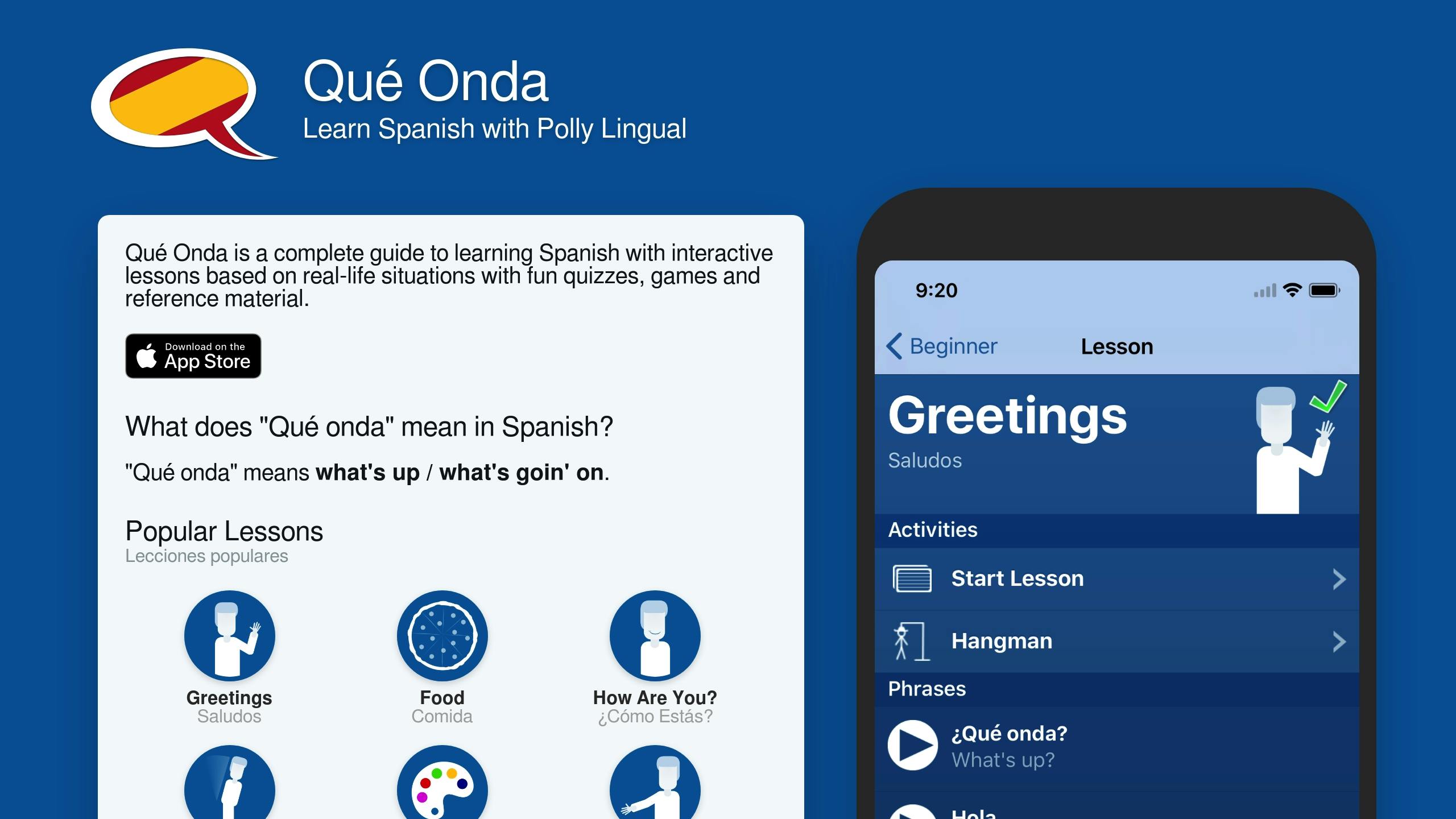Top 5 Apps for Spanish Pronunciation Practice
Want to improve your Spanish pronunciation? These 5 apps can help you master tricky sounds, stress patterns, and intonation. Whether you're struggling with rolled "r's" or need feedback on your accent, these tools provide real-time analysis, native speaker audio, and tailored lessons for all skill levels. Here's a quick overview:
- SpanishPod101: Real-time feedback, stress visualization, and lessons for all levels. Pricing starts at $8/month.
- Mondly: Instant voice feedback and stress practice with flexible learning plans.
- Rocket Spanish: Audio lessons and interactive exercises focused on rhythm and stress.
- Ouino: Customizable pronunciation modules with lifetime access for $149.99.
- Qué Onda: Affordable plans with interactive stress exercises starting at $9.99/month.
Quick Comparison Table
| App | Pronunciation Feedback | Stress & Intonation Tools | Price Range (USD) | Device Compatibility |
|---|---|---|---|---|
| SpanishPod101 | Yes | Visual stress markers | $8–$47/month | iOS, Android, Web |
| Mondly | Yes | Analyzes stress patterns | Under $10/month | iOS, Android |
| Rocket Spanish | Yes | Audio-based tools | Over $10/month | iOS, Android, Web |
| Ouino | Yes | Highlights stress markers | $12.99–$149.99 | iOS, Android, Web |
| Qué Onda | Yes | Interactive exercises | $9.99–$79.99 | iOS, Android |
These apps make practicing Spanish pronunciation easy and effective. Start with a free trial to see which one works best for you!
Spanish Teacher Tries Top 5 Spanish Apps
What to Look for in Spanish Pronunciation Apps
When choosing an app to improve your Spanish pronunciation, focus on tools that help you refine stress and intonation. Here are the key features to look for:
Speech Recognition Technology
Look for apps with advanced speech recognition that can pick up on small pronunciation differences. These tools help pinpoint areas where you can improve.
Native Speaker Audio
Apps with recordings from native speakers give you accurate examples to follow. High-quality audio is crucial for learning natural pronunciation. Some apps even include videos showing how to position your mouth correctly, making your practice more engaging.
Real-Time Feedback
The best apps provide instant feedback on your pronunciation, helping you adjust and improve as you practice.
1. SpanishPod101

SpanishPod101 is a language learning app designed to help you improve your Spanish pronunciation through a variety of audio resources and interactive tools. Its features are aimed at helping you practice and refine your accent effectively.
Real-time pronunciation feedback
The app uses speech recognition technology to analyze your pronunciation as you speak. It provides instant visual feedback, showing you where your pronunciation differs from native speakers. This allows you to quickly adjust and fine-tune your accent.
Emphasis on stress and intonation
SpanishPod101 focuses on teaching proper stress and intonation patterns in Spanish. Key features include:
- Visual markers to indicate where stress should fall in a word or sentence
- Audio comparisons that let you hear your pronunciation alongside native speakers
- Clear explanations of Spanish syllable stress rules
- Interactive exercises to tackle common pronunciation challenges
Tailored learning levels
The app offers lessons organized by skill level:
- Absolute Beginner
- Beginner
- Intermediate
- Advanced
Each level includes exercises specifically designed to match your current skill set, ensuring the content is neither too easy nor too difficult.
Pricing for US users (in USD)
SpanishPod101 provides several subscription options to suit different budgets and needs:
| Plan | Duration | Price | Features |
|---|---|---|---|
| Basic | Monthly | $8/month | Core pronunciation lessons and basic audio tools |
| Premium | Monthly | $25/month | Everything in Basic, plus voice recording and detailed feedback |
| Premium+ | Monthly | $47/month | All Premium features plus one-on-one pronunciation coaching |
All plans include a 7-day free trial, so you can explore the app's pronunciation tools before subscribing. For serious learners, the Premium plan provides full access to advanced speaking tools at a reasonable cost.
2. Mondly
Mondly is a language learning app designed to help users improve their Spanish pronunciation using speech recognition technology. It provides exercises aimed at enhancing clarity, fluency, stress, and intonation. Similar to SpanishPod101, Mondly emphasizes accurate pronunciation with targeted feedback.
Real-Time Voice Feedback
Mondly delivers instant feedback on your pronunciation. Here's what it offers:
- Quick analysis of how you speak
- Visual cues to show progress over time
Stress and Intonation Practice
The app includes exercises that focus on:
- Mastering syllable stress in common words and phrases
- Listening to recordings by native speakers to mimic proper intonation
Flexible Learning Levels
Mondly caters to learners at different stages with tailored practice sessions:
- Beginner: Simple word drills to build foundational skills
- Intermediate: Sentence-based exercises to develop natural rhythm
- Advanced: Detailed practice to fine-tune pronunciation
Subscription Options for U.S. Users
Mondly offers various subscription plans. For the latest pricing details and trial options, visit the official website.
3. Rocket Spanish

Rocket Spanish focuses on improving pronunciation through audio lessons and interactive exercises. It helps you fine-tune individual sounds and practice speech rhythm, making it easier to grasp stress and intonation patterns. With tiered lessons, you can move forward at your own speed while building confidence in speaking Spanish.
Accelerate Your Spanish Fluency
Explore top-rated Spanish language learning apps tailored to your proficiency and preferences. Start mastering Spanish today with interactive lessons, AI tutors, and engaging content.
4. Ouino

Ouino provides structured lessons to help users perfect Spanish pronunciation. It focuses on stress and intonation, offering a smooth pathway to its specialized modules.
Real-time pronunciation feedback
The app uses advanced speech recognition to analyze your speech and provides instant visual feedback. This feature highlights pronunciation errors, helping you spot and fix common mistakes English speakers often encounter when learning Spanish.
Emphasis on stress and intonation
Ouino includes modules designed to teach Spanish stress and intonation. Each lesson simplifies pronunciation rules into easy-to-follow steps, covering:
- Word stress across different verb tenses
- Intonation for questions and statements
- Variations in regional accents
- Patterns of syllable emphasis
Flexible learning options
The app offers customizable features to suit individual needs:
- Select exercises ranging from beginner to advanced levels
- Focus on specific sounds with custom practice sessions
- Progress at your own pace through pronunciation lessons
- Repeat challenging sections as often as necessary
These features make it easier to tackle common pronunciation challenges.
Pricing for US users (in USD)
Ouino provides several pricing plans to fit different budgets:
- Monthly subscription: $12.99
- 6-month access: $59.99 ($10/month)
- Annual access: $89.99 ($7.50/month)
- Lifetime access: $149.99 (one-time payment)
All plans include full access to pronunciation tools. Seasonal discounts are often available, making it a cost-effective choice for dedicated learners.
5. Qué Onda

Qué Onda provides subscription plans priced for the U.S. market and includes a free trial for first-time users. Here’s a quick look at the options:
| Plan Duration | Price | Features |
|---|---|---|
| Monthly | $9.99 | Unlimited access to pronunciation tools |
| Quarterly | $24.99 | Save 15% compared to monthly |
| Annual | $79.99 | Best deal with 33% savings |
Every plan grants full access to the pronunciation curriculum. Plus, new users can test it out with a 7-day free trial before committing.
Up next, we’ll dive into a side-by-side comparison of the app's main features.
App Features at a Glance
Here's a quick side-by-side comparison of some key features:
| Feature | SpanishPod101 | Mondly | Rocket Spanish | Ouino | Qué Onda |
|---|---|---|---|---|---|
| Pronunciation Feedback | Voice feedback provided | Real-time feedback available | Detailed voice analysis | Compare your pronunciation | Instant feedback offered |
| Stress & Intonation Tools | Visualizes stress and intonation | Analyzes stress patterns | Tools to compare pronunciation | Highlights stress markers | Interactive stress exercises included |
| Customization Options | Create custom word lists, adjust lessons | Set your learning pace | Plan lessons to fit your needs | Choose flexible lesson paths | Tailor practice sessions |
| Price Category | Under $10/month | Under $10/month | Over $10/month | Over $10/month | Under $10/month |
| Device Compatibility | iOS, Android, Web | iOS, Android | iOS, Android, Web | iOS, Android, Web | iOS, Android |
Next, let's dive into practical tips for mastering Spanish stress and intonation.
How to Practice Spanish Stress and Intonation
Improve your Spanish pronunciation by focusing on stress and intonation using specific tools in language apps. These features can help you overcome common pronunciation hurdles.
Start with Native Audio
Use the slow playback feature to study how native speakers pronounce words and phrases. Pay close attention to which syllables are stressed and how the pitch changes throughout a sentence.
Record and Compare
Once you’re familiar with native pronunciations, follow these steps to refine your accent:
- Listen to native audio carefully.
- Break down the word or phrase into syllables.
- Record your own attempt.
- Compare your recording to the original audio.
This method helps you pinpoint areas where your pronunciation differs and adjust accordingly.
Understand Stress Patterns
Spanish stress patterns are usually predictable. Use the app’s exercises to practice these basic rules:
| Word Ending | Stress Pattern | Example Word | Pronunciation Focus |
|---|---|---|---|
| Ends in a vowel | Second-to-last syllable | casa | CA-sa |
| Ends in -n or -s | Second-to-last syllable | hablan | HA-blan |
| Ends in other consonants | Last syllable | papel | pa-PEL |
| Contains an accent mark | Marked syllable | café | ca-FÉ |
Leverage Interactive Tools
Take advantage of interactive features in your app to improve faster:
- Watch video flashcards to see how native speakers move their mouths.
- Try gamified exercises that focus on specific pronunciation issues.
- Record entire phrases and get instant feedback on your stress accuracy.
Spending just 15 minutes a day on these activities can make a noticeable difference in your pronunciation.
Advanced Practice
For more challenging practice, record yourself reading full sentences or paragraphs. Many apps include lessons that gradually increase in difficulty, helping you tackle more complex stress and intonation patterns. Focus on the areas where you struggle the most to see steady improvement.
Next Steps
Here’s how you can improve your Spanish pronunciation step by step:
Set a Regular Practice Routine
Carve out time each day to focus on pronunciation. Whether it’s during your commute, a lunch break, or before bed, aim for 15-30 minutes of dedicated practice daily.
Focus on One Thing at a Time
Instead of overwhelming yourself, concentrate on mastering a single sound or stress pattern each session. This method lays a solid base for speaking Spanish naturally.
Here’s an example of a weekly plan:
| Day | Focus Area | Time | Practice Method |
|---|---|---|---|
| Monday | Vowel sounds | 15 min | Video flashcards |
| Wednesday | Consonants | 20 min | Recording exercises |
| Friday | Stress patterns | 25 min | Interactive lessons |
| Weekend | Full sentences | 30 min | Speech recognition |
Stick to this kind of schedule to steadily improve.
Monitor Your Progress
Use tools like progress charts or achievement badges to track how far you’ve come. Set manageable goals, such as learning five new pronunciation patterns each week, to keep yourself motivated.
Mix Digital Tools with Real-life Practice
- Listen to native speakers daily through audio recordings.
- Use speech recognition tools for instant feedback.
- Pair app-based exercises with real conversations and self-recordings to fine-tune your skills.
Many apps offer free trials - try one out to see if it fits your learning style before upgrading to a premium version.
FAQs
To find the best app for improving your Spanish pronunciation, start by assessing your current skill level - beginner, intermediate, or advanced - and think about how you learn best. Do you prefer interactive lessons, guided practice with AI tutors, or a fully customizable experience? Many apps cater to specific needs, such as focusing on stress, intonation, or conversational practice. Look for features that align with your goals and make learning engaging for you.
By choosing an app that matches your proficiency and learning style, you’ll stay motivated and see faster progress in mastering Spanish pronunciation.
When choosing an app to improve your Spanish pronunciation, prioritize real-time feedback and AI-powered tools that can analyze your speech and help you refine your accent. Apps with features like interactive exercises and customizable learning paths can also make practice more effective and engaging.
Additionally, look for apps that focus on intonation, stress patterns, and phonetics, as these are key to sounding more natural in Spanish. A well-designed app should adapt to your learning pace and provide clear guidance for mastering pronunciation step by step.
Some apps, like LingoFella and Verbai, include AI-driven tutors that adapt to your learning style and pace, which can assist in exploring different regional accents. While these features may provide exposure to various accents, the apps don’t specifically highlight tools dedicated solely to mastering regional variations in Spanish pronunciation.



 Mondly
Mondly

 Ouino
Ouino

 Qué Onda
Qué Onda

 Rocket Spanish
Rocket Spanish

 SpanishPod101
SpanishPod101

 LingoFella
LingoFella

 Verbai
Verbai